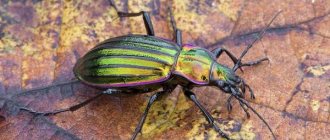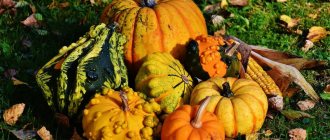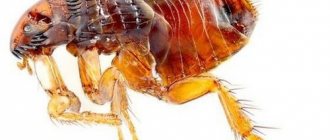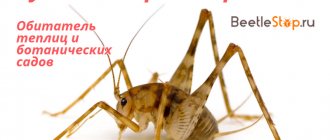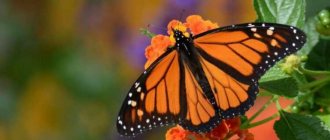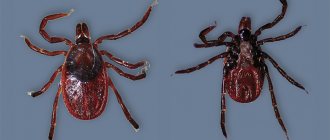During evolution, some insects changed the structure of the front pair of wings. The result was hard elytra filled with chitin. Because of this, the new order received the name “Coleoptera”, and popularly simply “beetles”. In terms of quantity and diversity, this is the largest group of living beings on the planet. Let's look at all the variety of species and in our review the most beautiful species of beetles living in nature.
Photos of the most beautiful species of beetles:
1
Ground beetles
Ground beetles (Carabidae) are mostly voracious predators. Strong legs and powerful jaws allow them to hunt successfully, destroying caterpillars, slugs and beetles. They live everywhere. The fauna of Russia and neighboring countries includes approximately 3,000 species.
A significant portion of ground beetles are black, but there are also colorful, bright exceptions
Fanous
Fan whisker beetles are known precisely for their gorgeous mustache, consisting of at least twenty segments and resembling thickly painted eyelashes.
They are so rare that they are one of the least studied representatives of their species today. Fanwhiskers live in Australia and can only grow up to 25 millimeters.
Whiskers serve males to pick up pheromones from females of their species, and to understand how ready the female is for mating. The number of male fanwhiskers significantly exceeds the number of females, so they often have to fight among themselves for a fertile individual.
Water bugs
The aquatic, predominantly carnivorous beetles include diving beetles (Dytiscidae), whirligigs (Gyrinidae), and water-loving beetles (Hydrophilidae). The first two families are active predators not only at the adult stage, but also at the larval stage; water lovers are omnivores, but mainly feed on plant foods.
The large black water lover (lat. Hydrophilus piceus) reaches 48 mm in length
Fruited nut
This is a very small bug with a very long proboscis, which is also often called the nut weevil. The nut fruit can be found in the European part of Russia and the Caucasus. The beetle's body is completely covered in brownish-yellow hairs, making it look like a miniature version of a sparrow.
Fruit veins emerge at the end of spring, when the weather is warm enough. They feed on leaves, hazel fruits, hazelnuts and acorns. Weevil larvae eat the nut kernel and fill its cavity with excrement. They are considered pests and are actively destroyed by owners of summer cottages.
Dead eaters
The orderlies of our fields and forests are carrion eaters (Silphidae). A large number of these beetles accumulate near the corpses of dead animals, dig under the corpse, scooping out the soil from under it. Thus, they lower the corpse into the ground, where they then eat it together with their larvae. One of the few beetles that care for their offspring: adults feed the larvae, although they are capable of feeding on their own.
Gravedigger, or black-whiskered gravedigger (lat. Nicrophorus vespilloides)
Lamellaridae
Lamellar beetles (Scarabaeidae), like many other beetles, are diversely represented in the tropics. 435 species of scarabaeids have been identified in the fauna of Russia. The largest tropical species is the African goliath, which was previously considered the largest among beetles. But later, a giant creaking creature larger than a goliath was discovered in the tropical forests of America.
Tropical bronze
Stag beetle
The stag beetle, a member of the stag beetle family (Lucanidae), is the giant of our forests; its length together with horns is 6-8 cm. This species is common in deciduous and mixed forests. Almost everywhere, the population of this species is low and continues to decline, so it is listed in the Red Books of both Russia and the countries where it lives. Male stag beetles have strong mandibles, similar to deer antlers, with which they fight. The larvae of these six-legged deer live in rotten stumps and hollows for five years before becoming beetles.
Duel between male stag beetles
Bottom line
Here we have presented a photo with the names of representatives of the Coleoptera order. To summarize, let us turn to the etymology of the word “beetles”. It comes from two ancient Greek words “scabbard” and “wing”. But Slavic is logically derived from the verb “buzz.” The editors of most-beauty.ru ask you to write in the comments what other beautiful species of beetles, in your opinion, should be included in this list.
And below we decided to post a few more beautiful photographs with different types of beetles:
That's all for now! We look forward to your comments.
Zlatki
Gold beetles (Buprestidae) are very beautiful. Golden, green, yellow, with multi-colored spots. All borers have a very durable shell. They feed on leaves or thin bark of plants, causing significant damage to plants. In sunny weather, beetles quickly run from one place to another along tree trunks heated by the sun; No wonder they are called “children of the sun.”
Chrysanthemum on a buttercup flower
Marbled beetle / Polyphylla fullo
A large representative of coleopteran insects of the Khrushchia subfamily. Adults grow up to 4 cm.
It is easy to recognize by its characteristic marble pattern. There are white spots of different shapes on the dark body. Because of this original coloring they received their specific name. At the front of the head are two large antennae.
A large beetle has spread throughout southern Europe. It feeds on leaves, flowers of fruit and agricultural plants. The larva happily eats plant roots.
Narynniki
Blister beetles (Meloidae) have bright, often spotted warning colors. The blood of these beetles contains cantharidin, a substance that causes deep ulcers on the skin.
Epicauta hirticornis
T-shirt scarred
ladybugs
We often encounter small predators - ladybugs (Coccinellidae). These are beneficial insects and are often used in biological control of plant pests.
Ladybugs eat aphids and scale insects
Seven-spotted ladybug
Leaf beetles
Among the brightly colored and often poisonous leaf beetles (Chrysomelidae), the Colorado potato beetle, which was brought from North America 100 years ago, is widely known. In its homeland, the striped beetle feeds on wild plants of the nightshade family, and in new conditions it has become a serious pest of potatoes.
The leaf beetle (lat. Chrysolina fastuosa) can feed not only on the leaf beetle, but also on nettles, mint and many other plants
Brazilian bigtooth lumberjack
One of the largest beetles in the world - the size of the largest individual of the Brazilian bigtooth woodcutter is 17.8 cm. It lives in the forests of Colombia, Brazil, Peru, Ecuador and Colombia.
This insect spends up to ten years in the larval stage, but the life of an adult woodcutter, alas, is limited to several months. Thanks to its very impressive size and beautiful colors, this beetle is a dream for any collector.
Dried specimens are considered an excellent interior decoration. Beetles are very expensive, but this does not bother exotic lovers - they like the opportunity to frame this rare and beautiful insect, and they are ready to pay any money for it.
Weevils
Bristle nodule weevil
Rice weevil
Barn weevil
Bark beetles
Previously, bark beetles were considered a separate subfamily, but now they are classified as weevils. Small beetles, pests of tree species. Adult beetles can make “ticking” sounds by tapping their heads against the walls of tunnels they have gnawed into wood - they can often be heard in old wooden houses at night. A number of species have a device for removing debris that interferes with movement along the passages - a depression in the elytra, which is called... a wheelbarrow! Yes, yes, friends, these are the only bugs with cars.
Great spruce beetle (lat. Dendroctonus micans)
Bronzovka
Another beautiful shiny bug. The bronze beetle also includes the well-known inhabitant of summer cottages - the cockchafer.
Some bronzes have the most common black color, without any hint of a beautiful metallic sheen. These beetles are much faster than their other flying counterparts. Shiny bronzes can be green, blue, copper and purple and gold.
Unfortunately, these beautiful beetles are pests - they eat young fruits of fruit crops, cabbage, carrots, and beet leaves, and also gnaw out the stamens and pistils of flowers, which makes their further pollination impossible.
Nutcrackers
Click beetles have short legs, and if they fall on their backs, it is difficult for them to roll over. To regain support under their feet, they use an original device - something like a lever, protrusions on the chest (they can be seen in the photo below), with which they cling to the abdomen, and, straightening out, jump into the air with a click. The larvae are called wireworms, and many of them cause damage in vegetable gardens by gnawing tunnels in root crops such as potatoes. Some species, such as the blood-red click beetle (so named because of the color of the wing covers), develop in rotten wood and do no harm.
Ocellated click beetle (lat. Alaus oculatus)
Fireflies
Representatives of this large family are nocturnal beetles. They have an interesting feature because they glow in the dark. And the reason for everything is oxidative reactions in organs located at the bottom of the abdomen of insects and called lanterns, sometimes they are distributed throughout the body.
Internal light reflectors are also involved in the glow. Moreover, this process is controlled by brain nerve impulses. Fireflies are able not only to “turn on” and “turn off”, but also to regulate the brightness of their “light bulbs” at will.
In this way, they mark territory, scare away enemies, call for sexual partners, and communicate their desires and intentions to their relatives. Light signals can be green, red, blue. And their frequency largely depends on individual and species characteristics, as well as environmental parameters.
Otherwise, fireflies are similar in structure to other beetles. They have an oblong, flat, hairy, brown, brown or black body; upper protective and lower delicate wings that enable flight; comb-like antennae composed of segments; large eyes; gnawing type oral formations, atrophied in adult individuals, since they do not feed on anything, unlike the larvae.
But there are exceptions, because the females of some species resemble dark brown worms in appearance, wingless and with six legs. In conclusion, we note that the presented species of beetles ( in the photo you can see what they look like) are only a small part of those existing in nature.
After all, Coleoptera are so widespread and numerous on the planet that even scientists themselves have no idea about the number of their species in nature. One can only assume that not all of them have been discovered and many of them have not yet been described.
